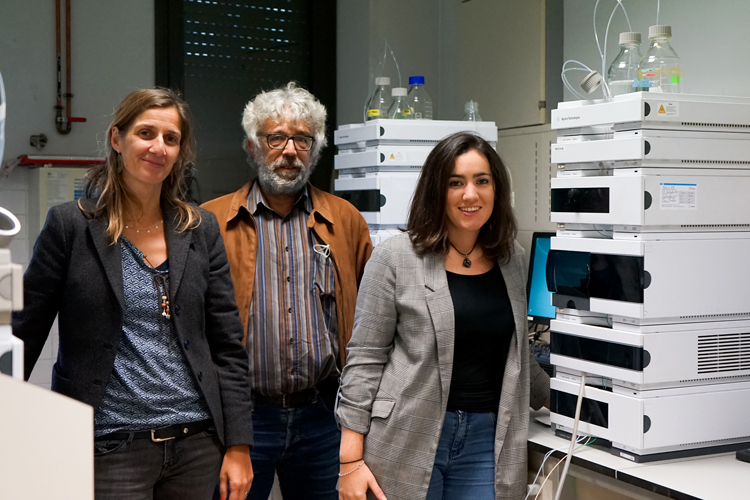In her doctoral thesis carried out in the Department of Bioengineering of IQS, Dr Núria Orive designed different metabolic engineering strategies to increase the production of glycoglycerolipids, interesting products due to their potential use as vaccine adjuvants or tumor suppressors.

Dr Núria Orive with Dr Magda Faijes and Dr Antoni Planas
Sustainable production is a European priority. Obtaining products in a manner that does not have a large environmental impact, while being commercially competitive at the same time, is one of the basic pillars that the European Commission has established for upcoming years.
Synthetic biology makes it possible to address the current problems industry faces using cell factories. This new strategy aims to produce products in a more efficient and more sustainable manner through cell factories, bacteria, or yeasts, which have been genetically modified and designed for the synthesis of a molecule of interest.
Glycolipids are products with high value due to their amphipathic properties that give them with a wide range of applications in the chemical (e.g., biosurfactants) or biomedical (e.g., vaccine adjuvant) sectors. Depending on the lipid unit, these compounds can be classified into different families. Thus, if the lipid unit is a ceramide or diacylglycerol, the resulting glycolipid will be known as a glycosphingolipid or glycoglycerolipid (GGL), respectively. While the former have been shown to play a key role in various biological processes, GGLs are interesting due to their potential use as vaccine adjuvants or tumour suppressors.
Although interest in these compounds is high, their application is hindered by their low availability and high production cost. Chemical synthesis requires complex protection and deprotection steps to achieve the desired regio- and stereospecificity of the glycosidic bond, which consequently leads to a reduction in the yield and efficiency of the process. Therefore, synthetic biology coupled with metabolic engineering offers the potential for the production of glycolipids.
In previous studies, the group led by Dr Antoni Planas reported1 that the glycolipid synthase enzyme MG517 from Mycoplasma genitalium was functional in E. coli and that GGLs were obtained from UDP-glucose (UDP-Glc) and diacylglycerol (DAG), molecules from this organism.
To increase the production of GGL in this first generation of strains, Dr Núria Orive recently defended her doctoral thesis "Design of a new biological platform for the production of glycoglycerolipids," supervised by Dr Magda Faijes Simona and Dr Antoni Planas Sauter, IQS professors. The thesis was carried out in the IQS School of Engineering Department of Bioengineering’s Biochemistry Laboratory in collaboration with Dr Marjan de Mey from the Center for Synthetic Biology at Ghent University in Belgium2 .
During the course of her thesis, five different metabolic engineering strategies were designed to increase GGL production using E.coli. The first four strategies aimed to increase the pool of the lipid precursor, DAG. The first strategy was based on increasing the availability of DAGs through the elimination of competing reactions. To achieve this, different genes involved in ß-oxidation and activation of fatty acids (∆tesA and ∆fadE) were knocked out and a nearly twofold increase in production was reported. The second strategy, based on increasing the availability of fatty acids through the formulation of transcription factors (fabR and fadR), did not see an increase in production but did report a change in the lipid profile with an increase in unsaturated fatty acids.
The third strategy was based on increasing the conversion of acyl donors to phosphatidic acid, a precursor of DAGs, overexpressing the acyltransferases PlsC and PlsB. The fourth strategy focused on increasing the availability of diacylglycerol for the overexpression of the fusion protein PlsCxPgpB, which is capable of redirecting the flow towards DAGs, or CDH promoting the hydrolysis of phospholipids. Among the different modified strains, ∆tesA, co-expressing MG517 and the fusion protein PlsCxPgpB, was the most productive strain, with a 350% increase in GGL production, compared to the parent strain expressing only the MG517 glycolipid synthase.
Finally, a metabolic strategy was also suggested to increase the availability of the other precursor, UDP-Glc. This fifth strategy was based on overexpressing the enzyme GalU, responsible for the biosynthesis of UDP-Glc, and eliminating the enzyme that codes for the UDP-sugar diphosphatase ushA. However, none of these modifications managed to improve the levels of GGLs.
This project has been carried out with support from the Spanish Ministry of Economy and Business’s BFU2016-77427-C2-1-R and BIO2013-49022-C2-1-R programme, IQS grants for doctoral studies, and the Societat Econòmica Barcelonesa d'Amics del País.

1 N. Mora-Buyé, M-Faijes, A.Planas, An engineered E.coli strain for the production of glycolycerolipids, Metabollic Engineering 14, 551-559 (2012)
2 N.Orive, T.Demulle, M. de Mey, M.Faijes, A.Planas, Metabolic engineering for glycerolypids production in E.coli: tuning phosphatidic acid and UDP-glucose pathways, Metabolic Engineering 61, 106-119 (2020)










